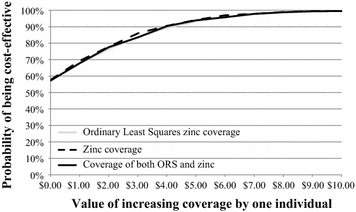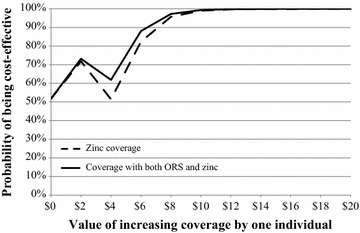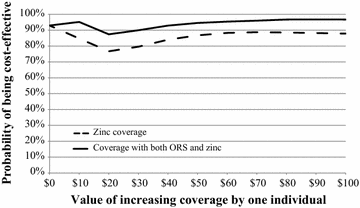Cost-effectiveness analysis of the diarrhea alleviation through zinc and oral rehydration therapy (DAZT) program in rural Gujarat India: an application of the net-benefit regression framework
- PMID: 28603456
- PMCID: PMC5465559
- DOI: 10.1186/s12962-017-0070-y
Cost-effectiveness analysis of the diarrhea alleviation through zinc and oral rehydration therapy (DAZT) program in rural Gujarat India: an application of the net-benefit regression framework
Abstract
Background: This study evaluates the cost-effectiveness of the DAZT program for scaling up treatment of acute child diarrhea in Gujarat India using a net-benefit regression framework.
Methods: Costs were calculated from societal and caregivers' perspectives and effectiveness was assessed in terms of coverage of zinc and both zinc and Oral Rehydration Salt. Regression models were tested in simple linear regression, with a specified set of covariates, and with a specified set of covariates and interaction terms using linear regression with endogenous treatment effects was used as the reference case.
Results: The DAZT program was cost-effective with over 95% certainty above $5.50 and $7.50 per appropriately treated child in the unadjusted and adjusted models respectively, with specifications including interaction terms being cost-effective with 85-97% certainty.
Discussion: Findings from this study should be combined with other evidence when considering decisions to scale up programs such as the DAZT program to promote the use of ORS and zinc to treat child diarrhea.
Keywords: Cost-effectiveness; Developing countries; Diarrhea; Implementation science; India; Net-benefit regression; Oral rehydration salts; Zinc.
Figures




Similar articles
-
Protocol for the economic evaluation of the diarrhea alleviation through zinc and oral rehydration salt therapy at scale through private and public providers in rural Gujarat and Uttar Pradesh, India.Implement Sci. 2014 Nov 19;9:164. doi: 10.1186/s13012-014-0164-2. Implement Sci. 2014. PMID: 25407053 Free PMC article.
-
Economic costs to caregivers of diarrhoea treatment among children below 5 in rural Gujarat India: findings from an external evaluation of the DAZT programme.Health Policy Plan. 2016 Dec;31(10):1411-1422. doi: 10.1093/heapol/czw083. Epub 2016 Jul 31. Health Policy Plan. 2016. PMID: 27476499
-
An external evaluation of the Diarrhea Alleviation through Zinc and ORS Treatment (DAZT) program in Gujarat and Uttar Pradesh, India.J Glob Health. 2015 Dec;5(2):020409. doi: 10.7189/jogh.05.020409. J Glob Health. 2015. PMID: 26682045 Free PMC article.
-
Review on development and community implementation of oral rehydration therapy.Indian J Public Health. 1994 Apr-Jun;38(2):50-7. Indian J Public Health. 1994. PMID: 7835996 Review.
-
Oral rehydration therapy programme in India: standard case management of acute watery diarrhoea.J Indian Med Assoc. 1995 Jun;93(6):220-6. J Indian Med Assoc. 1995. PMID: 7499892 Review.
Cited by
-
Cost-effectiveness of zinc supplementation for prevention of childhood diarrhoea in Tanzania.Public Health Nutr. 2022 Jul;25(7):1979-1988. doi: 10.1017/S1368980022000568. Epub 2022 Mar 11. Public Health Nutr. 2022. PMID: 35272738 Free PMC article.
-
Assessing the relationship of recommended diarrhea case management practices with the nutritional status of children aged between 0 to 59.9 months.Health Open Res. 2023 Nov 29;5:34. doi: 10.12688/healthopenres.13366.1. eCollection 2023. Health Open Res. 2023. PMID: 39677334 Free PMC article.
-
Measurement of benefits in economic evaluations of nutrition interventions in low- and middle-income countries: A systematic review.Matern Child Nutr. 2022 Apr;18(2):e13323. doi: 10.1111/mcn.13323. Epub 2022 Feb 8. Matern Child Nutr. 2022. PMID: 35137531 Free PMC article.
-
Economic evaluation of interventions to address undernutrition: a systematic review.Health Policy Plan. 2021 May 17;36(4):533-541. doi: 10.1093/heapol/czaa149. Health Policy Plan. 2021. PMID: 33280036 Free PMC article.
-
Methods used to account for caregivers' sex and gender within studies examining the financial burden of caregivers of children and adolescents : Results from a scoping review.Clinicoecon Outcomes Res. 2024 Jan 26;16:35-53. doi: 10.2147/CEOR.S443077. eCollection 2024. Clinicoecon Outcomes Res. 2024. PMID: 38298908 Free PMC article.
References
LinkOut - more resources
Full Text Sources
Other Literature Sources

